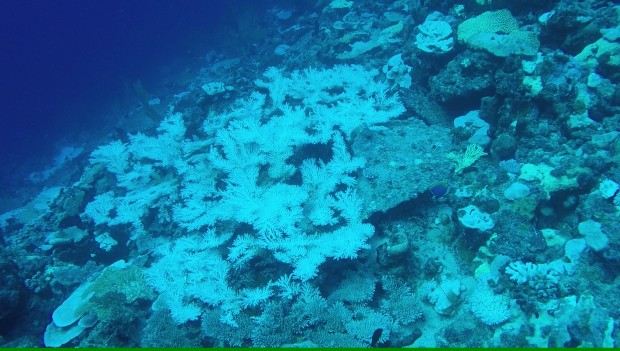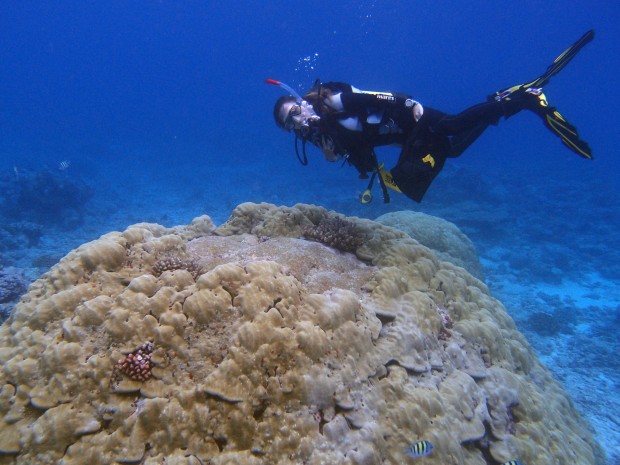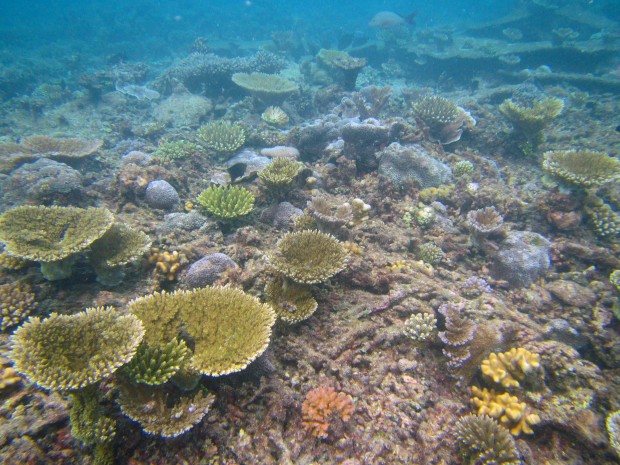Recent coral bleaching in the Chagos Archipelago
Dr Catherine Head, ZSL & University of Oxford
In the Anthropocene era, the Chagos Archipelago is one of a handful of marine locations in the world that is exposed to very few direct human impacts. Unfortunately, it is not immune to the global impacts of human-induced climate change.
One of the starkest examples of this was the 2015 and 2016 pan-tropical increase in sea surface temperatures (SSTs) as a result of an El Nino Southern Oscillation climatic event.
For the Chagos Archipelago reefs this led to a phenomenon known as coral bleaching, where the coral’s symbiotic relationship with their symbiodinium (single-celled algae) breaks down as a result of biochemical processes triggered when the coral is under stress. The symbiodinium provide the coral host with the majority of its energy so unless temperatures recover back to their ‘normal’ threshold quickly, it can result in coral death.
Earlier this year we reported in the journal Coral Reefs on the impact of the 2015 and 2016 thermal event on the Chagos Archipelago reefs.
Sadly, the picture was less than rosy, with almost 70% of hard corals on shallow reefs dying as a result of SSTs remaining above average for over seven weeks in 2015, and for 17 weeks in 2016! This is the first time that such increases in SSTs have been recorded in two consecutive years in the Chagos Archipelago’s waters, potentially indicating that the threat of climate change is ever increasing.

Interestingly, although the second thermal event lasted longer, a lower proportion of the surviving corals from the first event were killed.
The mechanism behind this is currently unknown, but it could be that the remaining corals are more resilient to higher temperatures, and their ability to endure and regenerate may be key to reefs surviving these acute rises in sea temperatures. This could provide some hope for the survival of the Chagos Archipelago’s valuable reefs, which support so much of the marine world’s biodiversity.
Some coral species suffered far more from the increases in SSTs than others. 86% of Acropora corals, previously the most abundant, perished. These are known to be the ‘weedy’ species on the reefs, growing quickly (for corals) but with little resilience to changes in the environment.
 The abundance of Porites corals on the other hand was not significantly affected and they became the dominant corals after the Acropora die-off.
The abundance of Porites corals on the other hand was not significantly affected and they became the dominant corals after the Acropora die-off.
This shift in species composition may permanently change the landscape of the reefs, reducing the complexity of the reef landscape, which has been shown to have negative effects on the number and diversity of fish and other creatures.
Having said that, many juvenile Acropora corals can now be seen on the reefs giving hope that these reefs will recover.
My work is now focusing on understanding where these juvenile corals are coming from – are they offspring of the few surviving Acropora colonies in the Chagos Archipelago, or are they from coral larvae that have travelled much further on the currents from other reefs in the Indian Ocean?
By understanding how connected coral larvae flow is we can better understand which reefs might be large sources of coral larvae and therefore a priority for protection.
 The Chagos Archipelago reefs have a history of high resilience, recovering from the last major thermal event in 1998, which resulted in similar levels of coral mortality, within approximately ten years. This ability to recover is partly attributed to the remote and protected nature of the Chagos Archipelago, meaning it has to withstand fewer impacts from human-driven activities such as fishing and pollution.
The Chagos Archipelago reefs have a history of high resilience, recovering from the last major thermal event in 1998, which resulted in similar levels of coral mortality, within approximately ten years. This ability to recover is partly attributed to the remote and protected nature of the Chagos Archipelago, meaning it has to withstand fewer impacts from human-driven activities such as fishing and pollution.
The big question now, with climate change increasing the frequency of these thermal events, is will the Chagos Archipelago reefs have enough time to recover before they are hit again?
----
Image 1: Bleached Acropora corals during the 2016 sea surface temperature increases © Daniel Bayley
Image 2: Massive Porites species such as this now dominate the reef landscape © Catherine Head
Image 3: Juvenile Acroporas, as seen here in 2019, have begun to re-establish themselves on the reefs following the 2015 & 2016 bleaching events © Catherine Head

